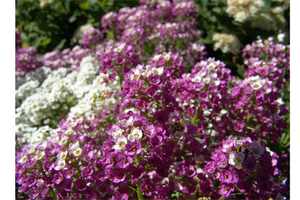Sweet alyssum (Lobularia maritima), is also known as carpet flower due to its tendency to spread out and provide ground cover. It grows to six inches to a foot tall, and is an annual plant in most growing zones, though in zones 10 and 11, and occasionally in zones 7, 8 and 9, it can function as a perennial. Sometimes the plants are mistaken for perennials, because they self-seed so much that gardeners may think the new plants are survivors from the previous growing season.
Sweet alyssum is known for its light, sweet fragrance. It has grayish green leaves, and clusters of tiny, cross-shaped four-petal flowers of pink, purple, or white.
The spreading plant is used to fill gaps in gardens and along walls and fences. It is a popular addition to rock gardens and xeriscapes, and is often planted around the edges of gardens and along walkways.
Many people grow sweet alyssum in hanging baskets and containers, though others feel that without enough room to properly stretch out, the plant is a bit too leggy to look its best in a container.
Sweet alyssum should be planted outside after the last frost. At that time, either grow it from seed, or transfer seedlings started in containers six to eight weeks earlier.
The plant does best in a moderately rich, loamy, well-drained soil of neutral pH. It should have full sun or close to it, certainly at least four to six hours of direct sun per day.
Cultivate the area where you intend to plant sweet alyssum with a garden tiller to a depth of six inches. Scatter the seeds onto the soil and tamp down, without burying them.
Don’t put the seeds too close together or they are more likely to rot. The mature plants too are more likely to rot if they are crowding each other. Sweet alyssum is a plant that likes to spread out and have room to breathe. A dense mat of leaves and flowers of multiple plants crowded together will not have enough air circulation.
Unless the soil is poor, you’ll need little or no additional nutrients, and in fact too fertile a soil can produce leggier, less attractive plants. At most, lightly apply liquid fertilizer diluted to half strength when you plant the seeds, add a little organic mulch around the seedlings after they emerge, and then lightly apply the diluted fertilizer once a month or so.
Keep the soil well watered until germination, which typically takes about two weeks. After that, water whenever the soil dries to a half inch depth, but don’t allow the soil to become water-logged.
Pull any weeds that appear around the plants.
Sweet alyssum blooms most in the cool seasons. It will bloom repeatedly throughout the growing season, but will fade and be least active during the peak heat of the summer.
Trimming the plants back by a half to a third will encourage new buds. Or at least deadhead to make more room for additional flowers.
If sweet alyssum is allowed to self-sow freely, it can become invasive and spread beyond where you intend.
Sweet alyssum is not particularly prone to disease or pests, except that it can sometimes have a problem with aphids. But be aware that the scent tends to draw bees and other non-pest insects, so it’s not the best plant to have in open areas where people gather, especially those who might be allergic to insect stings.
Sources:
Doug Green, “Growing Alyssum.” Simple Gifts Farm.
Marie Iannotti, “Sweet Alyssum (Lobularia) – A Fragrant, Easy to Grow Flower.” About.com.
“How to Grow Sweet Alyssum Flower.” Flower Scapes.




